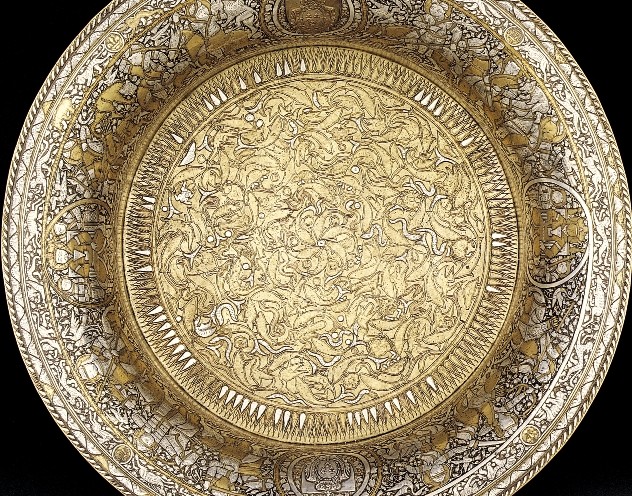Islamic Art: Resplendent at the Louvre

The long-awaited, much-ballyhooed new galleries of the Louvre dedicated to Les Arts de l’Islam have finally opened, ensconced beneath an undulating, translucent glass canopy roof in the Cour Visconti, a formerly unused courtyard in the museum’s Seine-side wing. Designed by architects Rudy Riccotti and Mario Bellini, the daring new one-story structure has all-glass walls that stand well clear of the courtyard’s ornate 18th-century facades, so the golden-glass canopy seems to float freely overhead.
But the light-filled courtyard building is only a small part of the new addition; the rest is underground, in an enormous open-plan gallery with dramatic dark gray walls and polished dark-gray floors flecked with brass. The two floors add up to more than 30,000 square feet of new exhibit space—and it’s hardly enough, given all it’s intended to display.
With well over 2,000 works dating from the 7th through the 18th century, covering a sprawling territory extending from Spain and Morocco to India, all beautifully presented and labeled in French, English and Spanish, the new galleries offer a brilliant show. But they are sorely in need of some clear organization. Interactive screens explain some works in detail, but there is no indicated route to follow, and countries and centuries sometimes seem to blend into one another almost at random.
But even for confused visitors, there are more than enough marvels to behold, many of them not on public show for decades—upstairs, an exquisite rock crystal pitcher from 11th-century Egypt, downstairs a dagger with a jewel-studded, carved jade handle in the shape of a horse’s head, from 17th-century India. The sturdy, stylized 12th/13th-century engraved bronze Lion of Monzón with a toothy, wide-open mouth, found in Spain, originally served as a fountainhead. An elaborate, gold-and-silver incrusted basin, from 14th-century Egypt or Syria, eventually wound up in French royal hands, used for the baptism of the future Louis XIII. There are 8th-century pottery fragments from archaeological digs at Suse, in Iran, and splendid rugs and illuminated manuscripts that will be rotated every six months or so to prevent overexposure to light.
And as if the riches of Islamic lands weren’t enough, the new galleries connect directly with another new section dedicated to the Roman Empire’s Eastern Mediterranean provinces, with superb Egyptian funerary portraits, sculptures, and almost the entire 6th-century mosaic floor of an early Christian church in Lebanon.
For more about the architect, see Rencontre: Rudy Ricciotti, France Today, March 2012.
Share to: Facebook Twitter LinkedIn Email
Leave a reply
Your email address will not be published. Required fields are marked *



